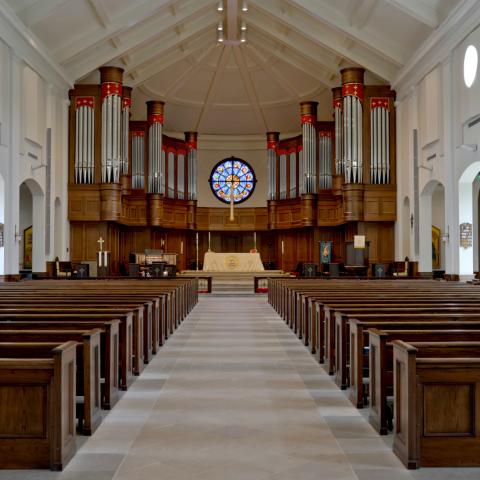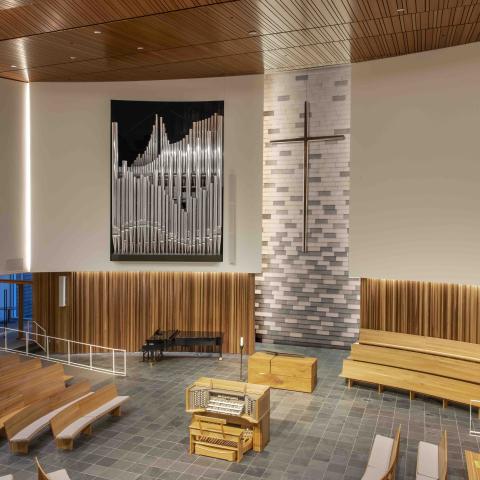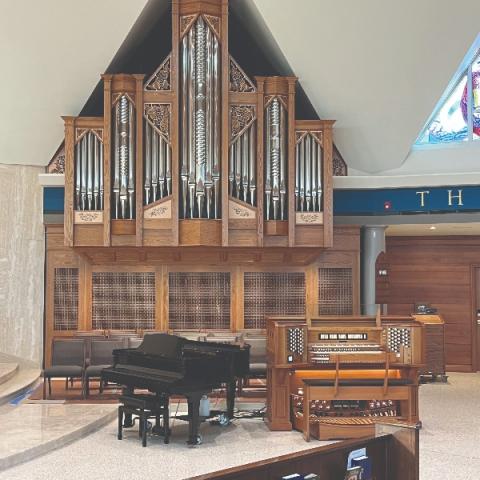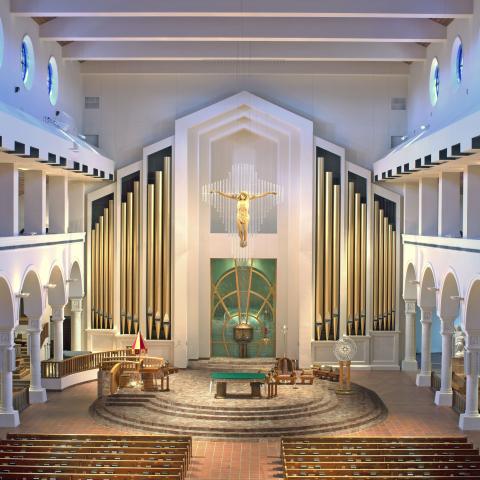Buzard Pipe Organ Builders, Champaign, Illinois; Pilgrim Lutheran Church, Carmel, Indiana, Opus 45, 2017; Central United Methodist Church, Fayetteville, Arkansas, Opus 46, 2018–2019
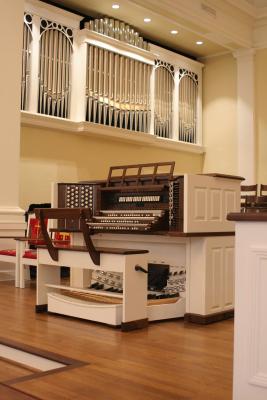
Opus 45
“What have you done here!?,” asked Todd Wilson as he leapt off the organ bench to greet me the day before Opus 45’s dedication. Hoping this was a friendly question, I asked to what exactly he was referring. “This organ just about plays itself!” Yes, it was a very friendly question and a complimentary one—even better.
What Mr. Wilson was referring to speaks to the heart of our organs’ playing mechanisms. Opus 45 was the first of our new organs in which our proprietary “Pallet Unit Chests” were used alongside our electrically operated slider and pallet windchests. More about this later.
Pilgrim Lutheran Church’s new long-hoped-for campus became a reality upon sale of their previous facility, the land being needed for a new entrance ramp to I-465. Early during their planning process, the organ committee selected Buzard Pipe Organ Builders for the instrument, and their architect, Jack Munson of Indianapolis, Indiana, asked us for dimensional and acoustical specifications. Imagine my delight and surprise when nearly ten years later Pilgrim Church’s cantor, Sarah Gran-Williams, called to tell me they were “ready for the organ!” And, imagine my further delight to discover Jack Munson had followed all of our recommendations, producing an intimate but lofty room, featuring four seconds of even reverberation, a nearly silent HVAC system and a perfect space for the organ case, choir, piano, and organ console!
The instrument at Pilgrim Lutheran Church in Carmel, Indiana is the 45th new pipe organ built by Buzard Pipe Organ Builders of Champaign, Illinois. It comprises 31 independent speaking stops and 37 ranks of pipes, distributed across two manual keyboards and the pedal keyboard. The instrument is housed in a free-standing case made of poplar, red oak, and walnut measuring 24 feet wide, 12 feet deep, and 35 feet tall. It was designed in concert with the building’s Prairie style architecture; every shape, line, and element of the room’s design is present in the organ case.
The Great and Pedal divisions are located in the top level of the case. The Swell division is placed in the center above the impost. The lower level contains the winding and mechanical systems and the Pedal 16′ Trombone. The blower and static reservoir are installed in a room located away from the sanctuary. The upper façade comprises polished tin pipes from the Great 8′ Open Diapason; the copper Festival Trumpets bisect the case in its center; the lower façade and two towers feature pipes from the Pedal 16′ Open Diapason beginning at low E (low C through D# are made of wood and lie horizontally behind the case) and the 8′ Pedal Principal.
We housed the color stops of the Great division in an expression box to provide additional expressive quality and accompanimental flexibility to this two-manual organ. Throughout our history we have tried to be “Traditional Visionaries” in situations in which space or financial resources were limited, resulting in subdivided Swell and Great divisions. This technique, originally utilized to overcome limitations, is becoming more a hallmark of our tonal style, in which equal emphasis is placed upon musical rendering of solo literature, accompanying, and congregational singing.
Buzard organs are custom designed, scaled, and voiced for each individual congregation’s musical tradition and acoustical environment. This means they differ one from another in execution, but an unmistakable musical thread runs through every Buzard pipe organ. The stop names are consistent from organ to organ, but the scaling and voicing of each is entirely determined by the specific circumstances that impact the creation. In this way, Buzard organs are works of functional art, designed and crafted to each and every client’s identity, while at the same time demonstrating a consistent personality of tone quality and artistic style.
This instrument honors its Lutheran patrimony by a slightly brighter outlook in the Principal choruses, inclusion of a German Romantic Clarinet and Oboe, and the slightly lighter 16′ Pedal registers. But it is a Buzard organ through and through in the enveloping warmth and majesty of Full Organ, its delicacy and sensitivity of tone in softer registrations, and its thrilling Swell reed battery. It has been called “a cathedral organ in a parish church.”
Back to Mr. Wilson’s observation of the playing actions. Buzard organs use electrically operated slider and pallet windchests to eliminate leather, providing an action that encourages sophisticated tonal results and stable tuning. Beginning with Opus 45, our organs’ unit stops (stops which play in multiple locations or at multiple pitches) and Pedal stops are played on actions identical to the slider chests—but without the slider stop actions. Our “Pallet Unit Chests” provide a key-channel expansion chamber for the wind for every pipe, just as the main slider chests, and they utilize identical magnets as the slider chests to open the unit chests’ pallets, giving the unit stops the exact same speech and repetition characteristics as the main slider chests. We are pioneers in the development of sensitive and responsive electric key actions. One can truly feel the difference; the musical result is palpable.
Our pipes are made of thick, high tin-content pipe metal (as well as wood and copper) rather than zinc. We support them in felt-lined traces and European racking systems that prevent the pipes from collapsing and further firms the tone produced. Additional support for the large façade pipes is provided by lining the interior of the feet with copper. Although far more expensive than the metal zinc, we believe traditional tin-rich pipe-metal produces better tone and is more in keeping with the permanent nature of a pipe organ investment.
We regulate our wind supply using single-rise reservoirs, schwimmer regulators, and concussion bellows to deliver a copious and steady wind supply, with a fine degree of flexibility. Our Tremulant actions send an adjustable timed-pulse to electric solenoids under the schwimmers, which both push and pull on the schwimmer plate to provide a perfect sine wave much like the human voice singing with “vibrato.” These actions are absolutely silent in their operation and extremely effective in both flue and reed stops.
Expression shutters are made of 2-inch-thick poplar, laminated to prevent warpage during seasonal changes, with heavily felted sound traps. Our expression boxes’ walls and ceilings are made of 1-inch MDF (the equivalent of 2 inches of solid hardwood) with 1½-inch-thick poplar stiles and rails, to produce an extremely effective swell expression. The shutters are moved by adjustable electric servo-motors.
Buzard organ consoles are intuitive in their layout and solidly built to last for generations. Their proprietary ergonomics of manual-to-pedal alignment allow for many playing hours without fatigue. The logical layout of drawknobs and couplers, toe-studs and expression pedals, encourages both technical accuracy and musical playing. Keyboards are plated in thick bone and ebony; the cabinets are made of 1½-inch-thick hardwoods.
We build all of our organs in sound reflective and protective cases, even when the organs are installed in chambers, as you will see we did in the second organ featured in this article for our Opus 46 organ at Central United Methodist Church in Fayetteville, Arkansas. We do this to provide excellent projection of sound into the room especially when chambers are located off the axis of the room (as in Opus 46) and to protect the organ from severe temperature fluctuations and potential building failure such as leaking roofs.
Cantor Sarah Gran-Williams said it best: “Buzard Organs sing, and they help us sing!” And, as Todd Wilson said: “This organ just about plays itself!”
Opus 46
In our Opus 46 organ at Central United Methodist Church in Fayetteville, Arkansas, we were given the wonderful opportunity to explore the nature of what a third manual keyboard could be, in light of our practice of enclosing a substantial portion of the Great. More than half of the Great is enclosed in an independent expression box with its own slider windchest. This allows the Enclosed Great to couple to any location we want and at any pitch. The Enclosed Great includes a flute chorus, a string, and four colorful reeds, so it can function like the unison basis of a Choir division. Additionally, by modifying and adding to the inhabitants of the Swell division’s Principal chorus, the Swell can serve as a Positiv division in the context of the classic secondary foil to the Great Diapason Chorus—as well as the enclosed powerhouse of the organ.
Therefore, with an enclosed portion of the Great, and suitable treatment of the Swell, we were free to consider a different way to approach the third manual division. This Solo division is loaded with tone colors at both higher and lower volume levels than the Great or Swell, so it can be a material contributor on the pianissimo and fortissimo ends of a seamless crescendo/diminuendo. When approached with this idea, organist Scott Montgomery embraced this vision—our next logical step in the evolution of the “Buzard Sound” and contemporary American organbuilding. Because the Enclosed Great and the Swell can move everywhere independently, Scott began to dream and consider the manifold uses to which such a tonal scheme could be used. Accompanying receives the first consideration of importance, because the rich choral program under Dr. Frode Gundersen’s direction regularly performs literature from literally every tradition. The organ can accompany the entire body of choral literature, and it can support hymnody and musically render just about any piece ever written for the organ. This is our goal. You can accompany Stanford and then play Vierne successfully; you can play Sweelinck for the opening voluntary and Sumsion for the closing voluntary, each with the effects the composer intended. And, because the instrument speaks clearly to the listeners in the nave—even though installed in off-axis chambers—the entire organ has an uncanny single voice, no matter how soft or loud it is registered.
In addition to exercising our evolving tonal style, Tonal Director Brian Davis and Production Director and Chief Engineer Charles Eames overcame what had seemed an impossible off-axis installation situation. Special scaling and voicing techniques, the addition of reflective panels above the pipes in the chambers, siting the divisions strategically for their best projection, constructing the organ in solid cases within the building’s chambers, utilizing slightly higher wind pressures and other techniques—and the tremendous improvement in the church’s acoustics provided by a comprehensive sanctuary renovation project—gave the organ the best chance of success.
When Scott Montgomery heard the organ’s first sounds as the organ came to life, all his fears concerning the off-axis installation were dispelled. He knew this would be a very special and important organ in the American lexicon. We rise to challenges and consider them opportunities to learn and improve. We’d love for you to visit this organ! Just call ahead!
—John-Paul Buzard, Founder, President, and Artistic Director, Buzard Pipe Organ Builders
Builder’s website: buzardorgans.com/
Pilgrim Lutheran Church: pilgrimindy.org/
Central United Methodist Church: centraltolife.com/
Photo credit: John-Paul Buzard
Opus 45, Pilgrim Lutheran Church, Carmel, Indiana
31 independent speaking stops, 37 ranks
GREAT – 3½″ wind
16′ Lieblich Gedeckt (wood)
8′ Open Diapason (façade)
8′ Flûte à Bibéron
8′ Gedeckt Flute (ext 16′ Gedeckt)
8′ Viola da Gamba
4′ Principal
4′ Spire Flute
2-2⁄3′ Twelfth
2′ Fifteenth
1-1⁄3′ Fourniture IV
16′ English Horn
8′ Minor Trumpet (ext Sw 16′ Bassoon)
8′ Clarinet
Tremulant
Cymbalstern (14 bells)
8′ Festival Trumpets (copper, chamade)
SWELL (expressive) – 3¾″ wind
8′ Open Diapason
8′ Stopped Diapason (wood)
8′ Salicional
8′ Voix Celeste (TC)
4′ Principal
4′ Harmonic Flute (round mouths)
2-2⁄3′ Nazard
2′ Octavin (harmonic)
1-3⁄5′ Tierce
2-2⁄3′ Grave Mixture II
1′ Plein Jeu III
16′ Bassoon
8′ Trompette
8′ Oboe
4′ Clarion (ext 16′ Bassoon)
Tremulant
8′ Festival Trumpets (Gt)
PEDAL - various pressures
16′ Open Diapason (wood and façade)
16′ Bourdon (wood)
16′ Lieblich Gedeckt (Gt)
8′ Principal (façade)
8′ Bass Flute (ext 16′ Bourdon)
8′ Gedeckt Flute (Gt)
4′ Choral Bass (ext 8′ Principal)
4′ Open Flute (ext 16′ Bourdon)
16′ Trombone (wood)
16′ Bassoon (Sw)
8′ Trumpet
4′ Clarion (ext Sw 16′)
8′ Festival Trumpets (Gt)
Opus 46, Central United Methodist Church, Fayetteville, Arkansas
43 independent speaking stops, 49 ranks
GREAT – 5″ wind
16′ Lieblich Gedeckt
8′ Open Diapason (façade)
8′ Flûte à Bibéron
8′ Gedeckt Flute (ext 16′)
8′ Viola da Gamba
4′ Principal
4′ Spire Flute
2-2⁄3′ Twelfth
2′ Fifteenth
1-1⁄3′ Mixture IV
16′ English Horn
8′ Trumpet
8′ Clarinet
8′ Vox Humana
Tremulant
Tremulant
Cymbalstern (Walker)
Chimes (Walker)
8′ Tromba (Ped 16′ Trombone)
4′ Tromba Clarion (ext 8′ Tromba)
8′ Major Tuba (Solo)
SWELL (expressive) – 6″ wind
8′ English Open Diapason
8′ Stopped Diapason
8′ Salicional
8′ Voix Celeste (CC)
4′ Principal
4′ Harmonic Flute
2-2⁄3′ Nazard
2′ Doublette
2′ Octavin (harmonic)
1-3⁄5′ Tierce
2-2⁄3′ Grave Mixture II
1′ Plein Jeu III
16′ Bassoon
8′ Trompette
8′ Oboe
4′ Clarion
Tremulant
8′ Tromba
8′ Major Tuba (Solo)
SOLO (expressive) – 7″ wind
8′ Grand Open Diapason (double mouths)
8′ Harmonic Flute
8′ Viola da Gamba (E. M. Skinner style)
8′ Gamba Celeste (CC) (E. M. Skinner style)
8′ Flûte Cœlestis (double mouth, wood)
4′ Principal Forte
4′ Flûte
Tremulant
8′ Major Tuba (15″ wind pressure)
8′ Harp (Walker)
4′ Celesta (Walker)
8′ Chimes (Walker)
PEDAL – 5″ wind
32′ Double Open Diapason (Walker)
32′ Subbass (Walker)
32′ Lieblich Gedeckt (Walker)
16′ Open Diapason (Walker)
16′ Bourdon
16′ Lieblich Gedeckt (Gt)
8′ Principal (façade)
8′ Bourdon (ext 16′)
8′ Gedeckt Flute (Gt)
8′ Spire Flute
4′ Choral Bass (ext 8′ Principal)
4′ Open Flute (ext 8′ Bourdon)
32′ Contra Trombone (Walker)
16′ Trombone (7″ wind)
16′ Bassoon (Sw)
8′ Tromba (ext 16′ Trombone)
8′ Trumpet
4′ Clarion (ext 16′ Trombone)
8′ Major Tuba (Solo)
8′ Chimes (Walker)
Photo: Opus 46, Central United Methodist Church, Fayetteville, Arkansas

